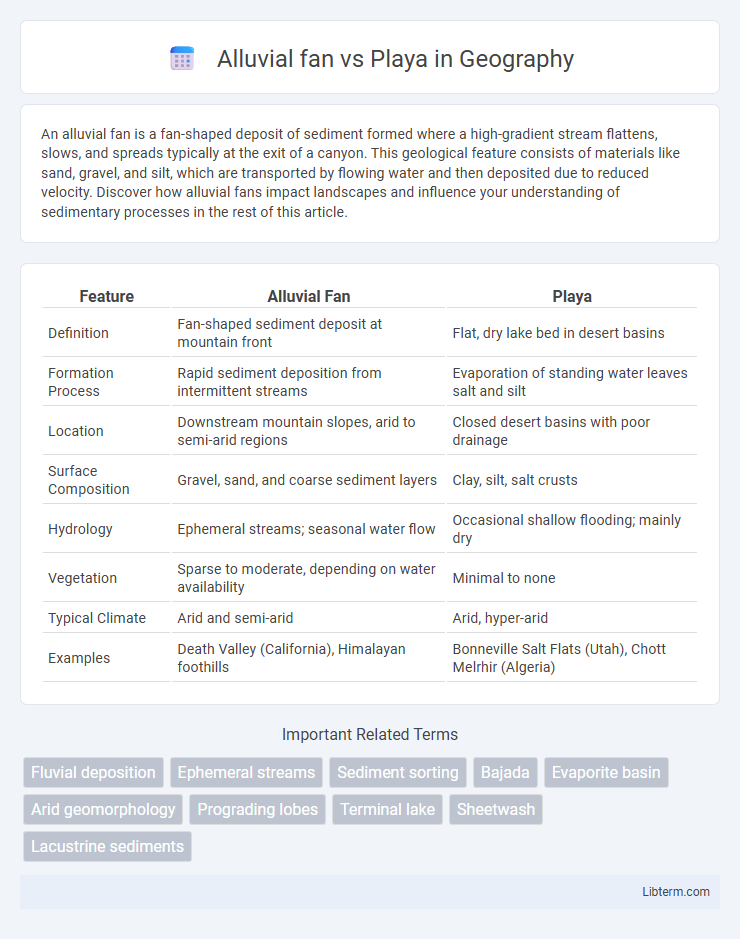An alluvial fan is a fan-shaped deposit of sediment formed where a high-gradient stream flattens, slows, and spreads typically at the exit of a canyon. This geological feature consists of materials like sand, gravel, and silt, which are transported by flowing water and then deposited due to reduced velocity. Discover how alluvial fans impact landscapes and influence your understanding of sedimentary processes in the rest of this article.
Table of Comparison
| Feature | Alluvial Fan | Playa |
|---|---|---|
| Definition | Fan-shaped sediment deposit at mountain front | Flat, dry lake bed in desert basins |
| Formation Process | Rapid sediment deposition from intermittent streams | Evaporation of standing water leaves salt and silt |
| Location | Downstream mountain slopes, arid to semi-arid regions | Closed desert basins with poor drainage |
| Surface Composition | Gravel, sand, and coarse sediment layers | Clay, silt, salt crusts |
| Hydrology | Ephemeral streams; seasonal water flow | Occasional shallow flooding; mainly dry |
| Vegetation | Sparse to moderate, depending on water availability | Minimal to none |
| Typical Climate | Arid and semi-arid | Arid, hyper-arid |
| Examples | Death Valley (California), Himalayan foothills | Bonneville Salt Flats (Utah), Chott Melrhir (Algeria) |
Introduction to Alluvial Fans and Playas
Alluvial fans are cone-shaped deposits of sediment formed where high-gradient streams exiting mountain ranges suddenly slow down and spread out in arid or semi-arid regions. Playas, also known as dry lakes, are flat, ephemeral basins found in desert environments that accumulate fine sediments and salt crusts after seasonal flooding and evaporation. Both landforms play critical roles in sediment transport and water drainage patterns in desert landscapes.
Formation Processes: Alluvial Fans vs. Playas
Alluvial fans form through the rapid deposition of sediment as flowing water exits a narrow canyon onto a flat plain, causing a fan-shaped spread of coarse material. Playas develop in arid basins where fine sediments settle and evaporite minerals precipitate from standing water, creating a dry lakebed. The key difference lies in alluvial fans being primarily sedimentary deposits from active water flow, while playas result from evaporation and sedimentation in closed, often ephemeral, basins.
Key Geological Differences
Alluvial fans form from sediment deposited by flowing water at the base of mountain ranges, characterized by coarse materials like gravel and sand spreading out in a fan shape. Playas are flat, dry lake beds found in arid regions, consisting mainly of fine-grained sediments such as clay and silt, often with salt crusts due to evaporation. Key geological differences include alluvial fans' association with active sediment transport and coarse deposits versus playas' accumulation of fine sediments in ephemeral lakes, highlighting distinct depositional environments.
Hydrology: Water Movement and Sediment Deposition
Alluvial fans form where high-energy streams deposit coarse sediments rapidly as water flow spreads out and slows upon exiting mountainous areas. Playas are flat basins with low-energy environments where water evaporates, leaving behind fine sediments and salts. Hydrologic processes in alluvial fans emphasize concentrated water flow and sediment sorting, while playas exhibit shallow, episodic flooding with fine sediment settling and evaporite accumulation.
Climate Influences on Alluvial Fans and Playas
Alluvial fans form primarily in arid to semi-arid climates where episodic heavy rainfall causes rapid sediment deposition at mountain fronts, while playas develop in extremely arid regions with high evaporation rates leading to ephemeral lakebeds. The climate's precipitation variability influences the sediment supply and water retention, making alluvial fans more dynamic and playas more prone to desiccation and salt crust formation. Temperature fluctuations and limited rainfall intensity are crucial factors controlling the morphology and hydrology of both landforms.
Vegetation and Ecosystem Characteristics
Alluvial fans support diverse vegetation due to well-drained soils and intermittent water flow, fostering ecosystems with drought-resistant shrubs and grasses. Playas, characterized by salty, flat lake beds, host sparse, salt-tolerant vegetation adapted to saline and ephemeral wet conditions. These contrasting environments result in distinct ecosystem dynamics, with alluvial fans promoting more robust plant communities compared to the limited flora in playas.
Typical Locations and Global Distribution
Alluvial fans typically form at the base of mountain ranges in arid to semi-arid regions, with prominent examples found in the southwestern United States, the foothills of the Himalayas, and the Andes. Playas are flat, dry lake beds commonly located in interior desert basins such as the Great Basin Desert in the USA, the Sahara Desert, and the Turpan Depression in China. The global distribution of alluvial fans is closely tied to active tectonic zones with episodic sediment supply, while playas dominate in endorheic basins where evaporation exceeds precipitation.
Geomorphological Significance
Alluvial fans are cone-shaped deposits formed by sediment-laden water flowing from narrow mountain valleys onto flatter plains, playing a critical role in sediment distribution and landscape evolution. Playas, or dry lake beds, represent evaporative basins where fine sediments accumulate, highlighting climatic aridity and groundwater dynamics in arid regions. Both features serve as key indicators of hydrological processes and environmental conditions in desert geomorphology.
Human Impact and Land Use
Alluvial fans support agriculture and settlements due to their fertile soils and better drainage, making them more prone to human modification like irrigation and urban development. Playa lakes, often ephemeral and saline, have limited agricultural use but are sometimes exploited for mineral extraction or recreational activities, leading to habitat disturbance. Human activities on alluvial fans can increase erosion and sedimentation downstream, while land use on playas risks disrupting unique ecosystems and altering natural hydrology.
Summary: Comparing Alluvial Fans and Playas
Alluvial fans are cone-shaped deposits formed by sediment-laden water flowing down mountain slopes, characterized by coarse sediments and rapid water discharge. Playas are flat, dry lake beds found in arid regions, dominated by fine-grained sediments and periodic evaporation leading to salt flats. The key difference lies in their formation processes: alluvial fans result from active sediment transport and deposition, while playas form from the accumulation and evaporation of water in closed basins.
Alluvial fan Infographic

 libterm.com
libterm.com